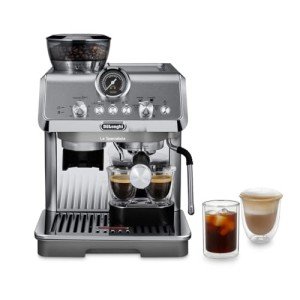What's The Reason You're Failing At Home Use Espresso Machines

Home Use Espresso Machines: A Comprehensive Guide
Espresso machines have ended up being a staple in numerous families as coffee lovers seek to duplicate café-quality brews in the convenience of their kitchen areas. The rise in popularity has caused a diverse market filled with numerous models, features, and prices. This article aims to supply an informative introduction of home use espresso machines, helping readers browse their alternatives effectively.
Understanding Espresso Machines
Espresso machines work by requiring warm water through finely-ground coffee under high pressure, resulting in a focused coffee beverage called espresso. There are numerous types of espresso machines classified based upon their brewing techniques and level of automation. The most common types consist of:
- Manual Espresso Machines: These need the user to manage the pressure and water circulation, permitting a more hands-on coffee-making experience.
- Semi-Automatic Espresso Machines: These provide automatic control over water pressure, while the user by hand grinds and tamps the coffee.
- Automatic Espresso Machines: With the push of a button, these machines instantly control the flow of water, making it simpler to brew espresso with consistent outcomes.
- Super-Automatic Espresso Machines: These all-in-one machines handle grinding, tampering, developing, and even milk frothing, making them perfect for users trying to find convenience.
- Pill or Pod Machines: These use pre-packaged coffee pods to develop espresso with minimal effort, but they restrict choice in brewing techniques and tastes.
Table: Comparison of Espresso Machine Types
| Type | Control Level | Alleviate of Use | Cleaning up Level | Perfect For |
|---|---|---|---|---|
| Manual | User-controlled | Moderate | High | Coffee purists |
| Semi-Automatic | Partial automation | Moderate | Moderate | Home baristas |
| Automatic | Fully automated | Easy | Low | Busy people |
| Super-Automatic | Fully automated | Really easy | Extremely low | Convenience hunters |
| Capsule/Pod | Completely automated | Really easy | Extremely low | Casual drinkers |
Key Features to Consider
When choosing a home use espresso machine, it's necessary to think about numerous features that can substantially impact the quality of espresso and user experience.
- Pressure: Look for machines that offer at least 9 bars of pressure, as this is considered ideal for developing espresso.
- Boiler Systems: Single vs. dual boiler systems figure out temperature stability and the capability to brew espresso and steam milk at the same time.
- Grinder: Integrated grinders permit for freshly ground coffee, which boosts taste. Consider machines with adjustable grind settings.
- Milk Frother: For those who take pleasure in cappuccinos and lattes, an integrated steam wand or automatic frother is crucial.
- Size and Design: Consider your cooking area space and aesthetic preferences. Machines come in various sizes, from compact to big setups.
- Price: Home espresso machines can range from a few hundred to several thousand dollars, so it's crucial to develop a budget before exploring options.
Pros and Cons of Home Use Espresso Machines
| Pros | Cons |
|---|---|
| Convenience of brewing coffee in your home | Initial investment can be high |
| Quality of espresso is typically exceptional | Requires some ability, specifically with manual machines |
| Ability to try out flavors | Upkeep and cleaning can be labor-intensive |
| Can conserve money in the long run | Not all machines will match every coffee preference |
Maintenance and Cleaning Tips
Keeping an espresso machine is crucial for prolonging its life and guaranteeing constant brew quality. Here are some helpful tips:
- Regular Descaling: Minerals from water can construct up in the machine. Descale every 1-3 months, depending upon water firmness.
- Daily Cleaning: Rinse portafilters, baskets, and steam wands after each use to prevent coffee oils from developing residue.
- Use Filtered Water: This can help in reducing mineral accumulation and improve the taste of coffee.
- Replace Gaskets and Seals: These components may use out in time and must be replaced to preserve pressure and performance.
- Check out the Manual: Each machine has particular care guidelines; following these will make sure durability.
Frequently Asked Questions About Home Use Espresso Machines
Q1: What is the best budget espresso machine?The best budget espresso machine typically depends upon specific needs, however designs like the DeLonghi EC155 or the Breville Bambino are popular amongst users for supplying terrific worth. Espresso Maker Online : How long do home espresso machines typically last?With proper upkeep, home espresso machines can last anywhere from 5 to 15 years, depending on the quality of the machine and frequency of use. Q3: Can I make cappuccinos and lattes with any espresso machine?While most espresso machines can make cappuccinos and lattes, having a reputable
steam wand or frother is necessary for achieving the best milk texture.
Q4: Are super-automatic machines worth the investment?For those who prioritize benefit and quick developing, super-automatic machines can be worth the financial investment, though they might lack some customizability in brew strength and taste. Q5: What types of coffee beans are best for espresso?While individual preference contributes, beans identified as" espresso "blends are normally roasted darker, creating rich tastes and a creamy texture when brewed.
Buying a home espresso machine can transform the daily coffee regimen into something special, raising home brews to café quality. By understanding the various kinds of machines, essential functions to consider, maintenance requirements, and weighing the
benefits and drawbacks, consumers can make educated choices that suit their specific choices. As the espresso culture continues to grow, no matter the option, every brew can be a tasty experience waiting to be appreciated.

